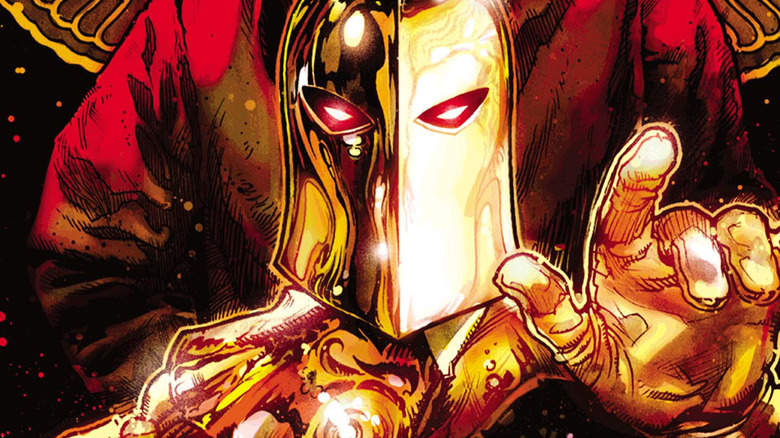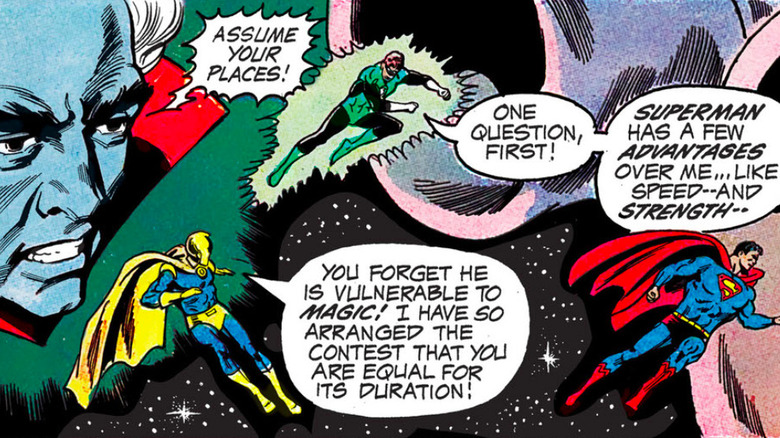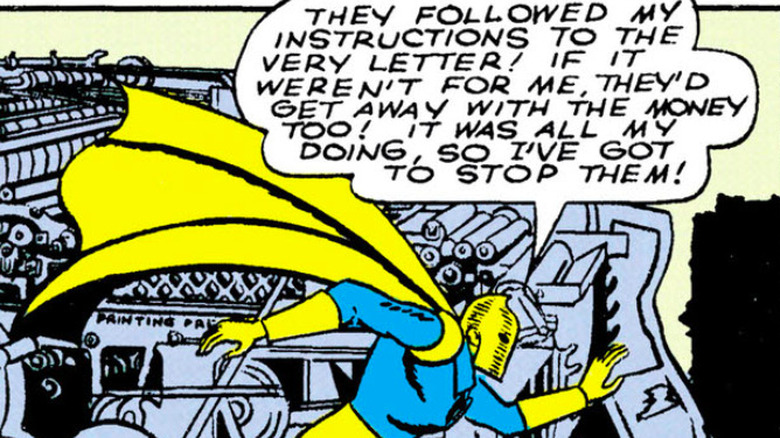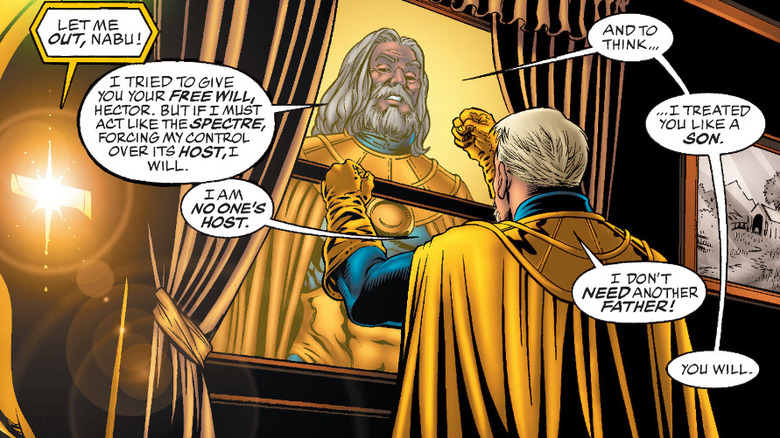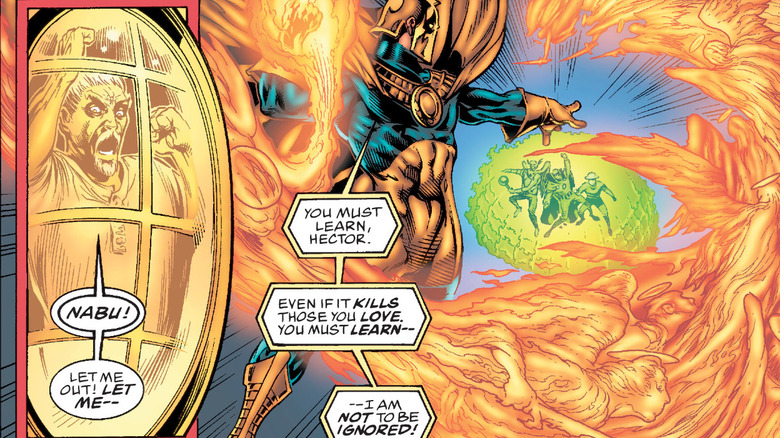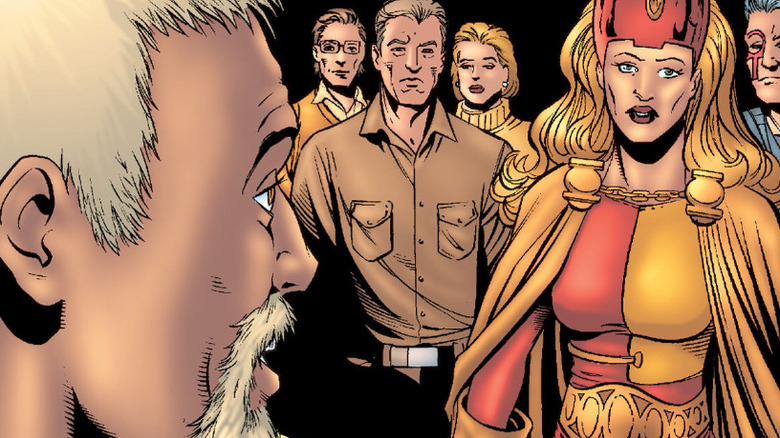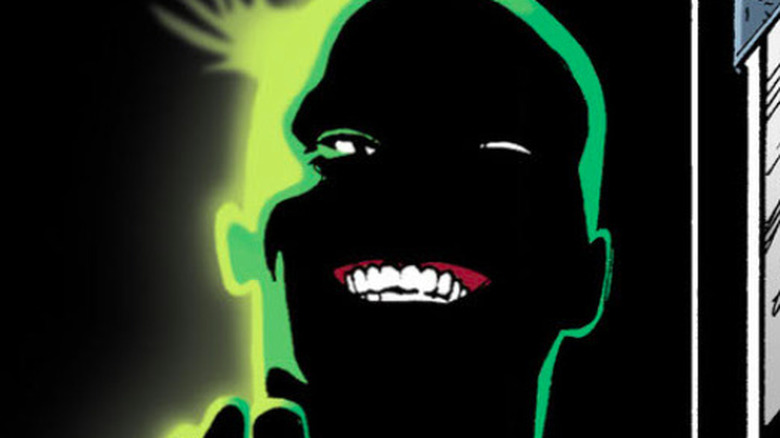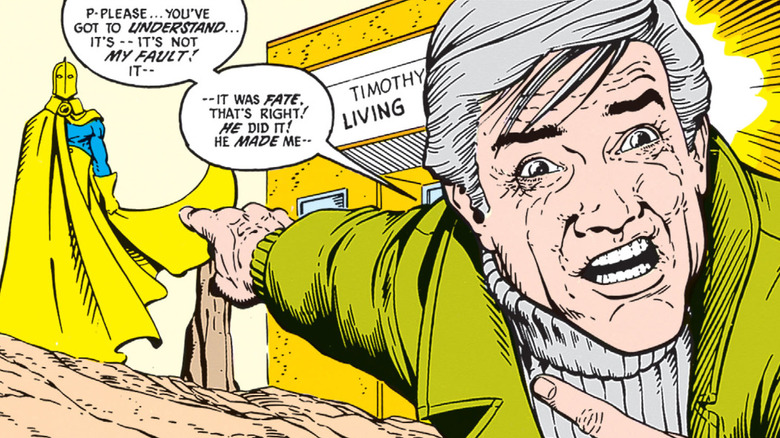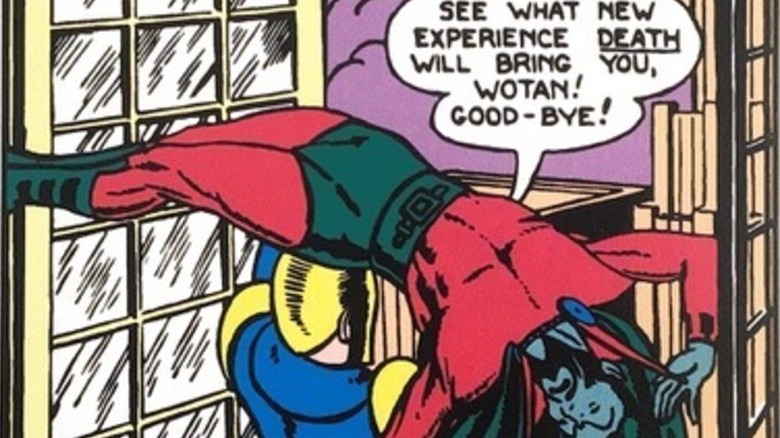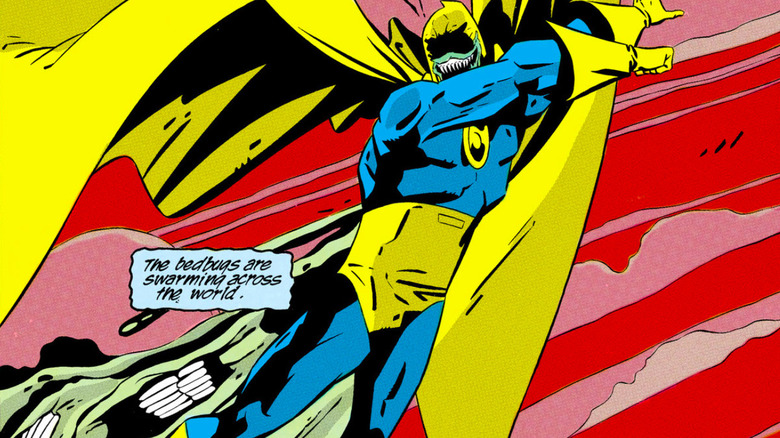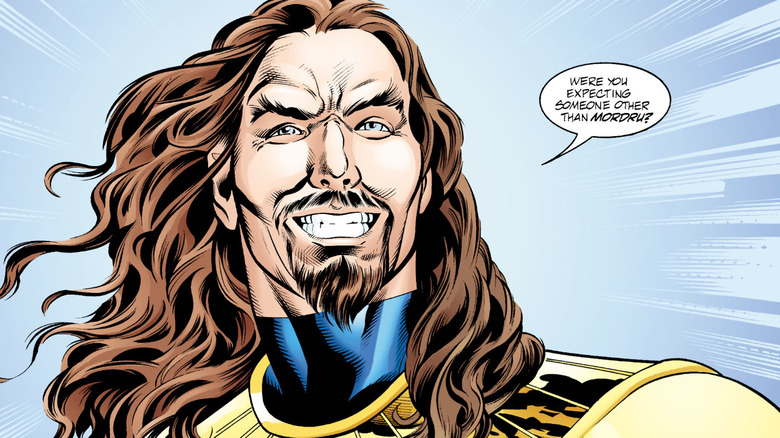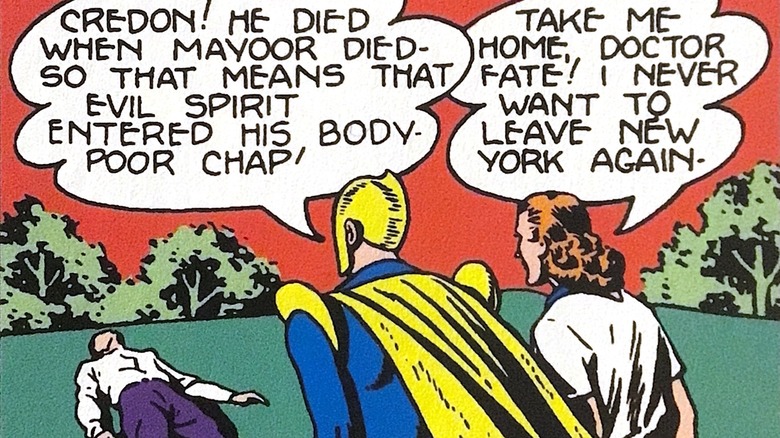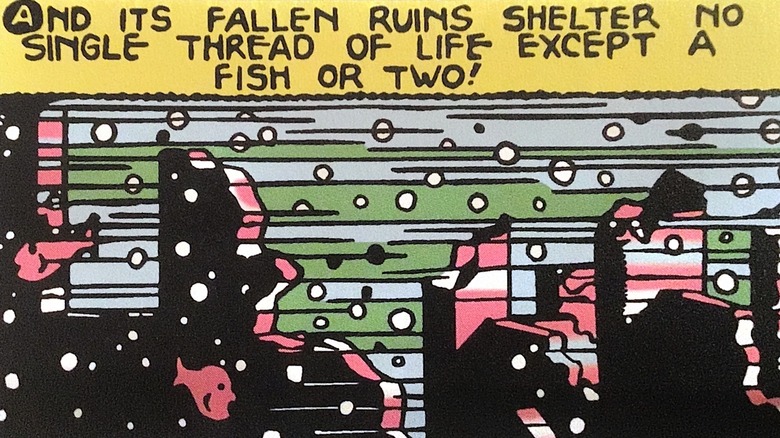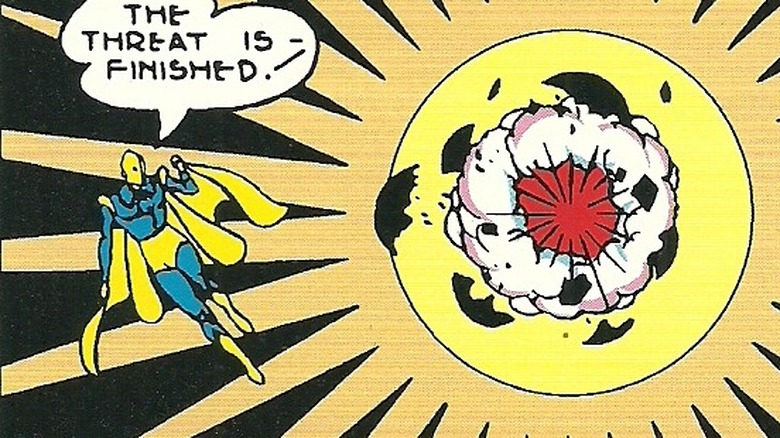The Worst Things Doctor Fate Has Ever Done
When a magical menace threatens the DC Universe, you truly can leave it up to fate — or can you? First materializing in 1940's "More Fun Comics" #55 by Gardner Fox and Howard Sherman, Doctor Fate is one of the DC Universe's most powerful and well-known mystics, serving the Lords of Order and at times the Lords of Chaos and established Egyptian deities like Thoth. Unlike other well-known DC mystics or the character's Marvel Comics counterpart, Doctor Strange, anyone who wears the costume's mystical golden helmet and amulet can become Fate, although being predestined or chosen to wield the power are often prerequisite.
As a result, many people have taken up the Doctor Fate identity. The most famous, however, is the first Kent Nelson, whom Pierce Brosnan plays in 2022's "Black Adam." While Kent and his successors have been mostly heroic, the Helm of Fate has at times driven them to do some morally questionable things, in part thanks to Nabu, the wizard who taught Kent the mystic arts and the original spirit residing within Fate's helmet. There's also been the odd Fate host who's been downright malevolent, using the awesome power Fate's costume gives them to engage in some large-scale malice. So just what are these despicable, even downright atrocious deeds, you ask? Follow the stairways of the Tower of Fate and wipe those ectoplasmic screens, because it's time to examine the worst things Doctor Fate has done in the comics.
Doctor Fate pit Green Lantern and Superman against their greatest fears
Superman isn't particularly known for having too many grudges against other heroes, especially before "Crisis on Infinite Earths." Yet he and Green Lantern Hal Jordan get into quite a spat in "World's Finest Comics" #201 by Dennis O'Neil and Dick Dillin while handling a dangerous meteor shower. A Guardian of the Universe (one of Hal's "bosses," as it were) decides to settle things by pitting the two heroes to a contest to determine who gets to continue patrolling Earth. Rather than officiate the contest himself, however, the Guardian recruits Doctor Fate to do the honors, despite the mage having no involvement with the Green Lantern Corps.
Thus Superman and Green Lantern are placed through some big ordeals, including facing a dragon and the one thing that scares each of them the most: an oversized yellow spider, in Hal's case, and his father Jor-El's disapproval, in Superman's. The Man of Steel quickly realizes his and Green Lantern's fears are just constructs Fate's created with magic, however, and after conquering his "fear" and joining Hal in defeating the dragon, Superman deduces they're actually dealing with Felix Faust, who's disguised himself as Fate and the Guardian. Realizing the whole contest's a sham, Superman and Hal destroy Faust's Doctor Fate disguise and send the fake Doctor Fate to the authorities.
Doctor Fate wrote a guide on how to rob banks
Being a criminal can be hard when there are superheroes around. Not so much, however, when those same heroes give you tips on how to pull off heists themselves. That's what Kent Nelson ends up doing by accident in an "All-Star Comics" #7 segment by Gardner Fox and Stan Aschmeier. Kent writes a how-to piece on foiling and carrying out crimes to win a $25,000 newspaper contest. Unbeknownst to him, however, the people behind the contest are members of the Crime Writers League, a group of gangsters looking for ways to up their crime game. While Kent wins the contest, the League mistakenly thinks it's his romantic interest, Inza Cramer, who's written the essay, and they kidnap her in an attempt to recruit her for their sneaky schemes.
Naturally, Inza refuses, and the Crime Writers League retaliates by tying her up in a room with a bomb. Fortunately, Kent arrives as Doctor Fate in time to save Inza, and later stops the League from putting his tips into practice at the California Indemnity Bank after hours. Once the bank's owner learns of Fate's actions, he agrees to reward him with $100,000 so Kent can donate it to charities that help children severely impacted by World War II. Sure, unwittingly giving crooks thieving advice isn't one of Fate's finer moments, but it's hard to deny it works quite alright for him in the end.
Doctor Fate controls its host
Can you control fate, or does it control you? If Nabu's involved, you might find yourself siding with the latter. As "Who's Who: The Definitive Directory of the DC Universe" #6 explains, Nabu often tries taking the driver's seat whenever anyone dons the Doctor Fate helmet, to varying success. This is especially true in the case of Kent Nelson, who despite trying to get around the issue by temporarily switching helmets, actually becomes bonded to Nabu even when not in costume for a time. Hector Hall, formerly the Silver Scarab and the son of Hawkman and Hawkgirl, also has to deal with Nabu's heavy-handed influence, although he's still somewhat in control at the beginning. Interestingly, Nabu has a much smoother bond with recent Fate host Khalid Nassour, eventually deciding to give up possessing him entirely after overcoming a brief turbulent patch in which Nabu sought to destroy all magic.
There are some, however, who've prevented Nabu's control entirely against his will. Eric and Linda Strauss, for instance, avoid falling under Nabu's sway by merging into one being when they become Doctor Fate, although Nabu continues mentoring them by inhabiting the deceased Kent Nelson's body. Similarly, others besides Nabu have tried to control Doctor Fate – Inza Cramer, for instance, deals with the manipulations of a Lord of Chaos during her tenure as the mystic hero. The helmet has also housed the deity Hauhet (of Egyptian myth), though it's unclear if she's as controlling as Nabu could be.
Nabu supported Black Adam's coup
In the "JSA" and "Hawkman" story "Black Reign" by Geoff Johns, Don Kramer, and Rags Morales, Black Adam has a small group of former JSA members and allies join him in taking over his native city of Kahndaq. Nabu, who once served with Black Adam's previous incarnation, Teth-Adam, centuries ago under Prince Khufu (a past life of Hawkman's), feels strongly sympathetic toward his old ally's cause, given the oppressive nature of the government Adam has just deposed. Yet he fails to convince Hector Hall, Hawkman's son, creating tension that culminates in Nabu forcibly trapping Hector's psyche in the Amulet of Anubis while taking control of his body.
Now full-on "Team Adam," the Nabu-controlled Doctor Fate attacks Hector's teammates, although JSA powerhouses Flash (Jay Garrick) and Green Lantern (Alan Scott) quickly rise to the occasion. Ultimately, Nabu's alliance with Black Adam is short-lived, as Hector manages to get control over his body back with a little unexpected help.
Nabu imprisoned Fury and past hosts in his amulet
Stargirl gets quite a pleasant surprise when she first enters the Amulet of Anubis in "JSA" #3 by James Robinson, David S. Goyer, and Stephen Sadowski: namely an idyllic realm where Nabu and every deceased incarnation of Doctor Fate reside, as well as fellow superhero Kid Eternity. It's not long before Hector Hall, then the new Doctor Fate, pays the world within the amulet a visit himself, which ends up serving as both a refuge and a place where he can ask his predecessors for help. He gets quite a shock, however, in the "Princes of Darkness" storyline, in which "Kent Nelson" claims he, Kid Eternity, and his fellow Fate alumni are mental constructs of Hector's, while Nabu claims he's the sole spirit actually within the amulet.
Both assertions, however, turn out to be bare-faced lies. When Nabu traps Hector Hall's spirit in the amulet during "Black Reign," Hector not only learns that Fate's past hosts are indeed within, but so is his wife Lyta Hall aka Fury. What could have been a happy reunion is further soured by Fury's reveal that they are all Nabu's prisoners. By combining their powers in a mystical incantation, the Fates bring Nabu back into the amulet to imprison him, while Hector frees both himself and Fury. Shortly thereafter, Lyta and Hector rejoin the Fates within the amulet to ensure that Nabu continues acting as a power source for Hector, but without the mind control.
Doctor Fate trapped a man as a shadow forever
Criminal scientist Ian Karkull poses a unique challenge to Doctor Fate in "More Fun Comics" #69. Having invented a device that can turn people and objects into living shadows, Karkull has come up with a pretty inventive way to commit crimes without being caught or harmed. At first, he hires crooks to commit crimes as shadow-beings for him, but when Fate tracks him down and subdues his crime posse, Karkull turns himself into a shadow so he's immune to Fate's attacks. He is one-upped, however, when Fate destroys Karkull's machine, reasoning that leaving him as a shadow permanently and thus unable to touch anything would effectively render Karkull harmless.
Yet Fate does not consider that Karkull would receive help in getting even in issue 70, namely from Wotan, a malevolent wizard Fate traps underground in #56. Wotan uses his special abilities to coordinate his escape with Karkull's help, and the two confront Fate, but their battle ends when Wotan's mystical fire backfires on him and Karkull. Again, however, Karkull survives, but he meets his end for real decades later in "JSA" #8 by David Goyer, Geoff Johns, and Stephen Sadowski, when he's killed by the shadow powers of Obsidian.
Doctor Fate got the Gray Man killed
Poor Gray Man. The major villain of the early "Justice League" and "Justice League International" issues by Keith Giffen, J.M. DeMatteis, and Kevin Maguire is penalized — or so he believes — for the mere crime of curiosity. Forced to collect the "dream-essence" of those on the verge of death for the Lords of Order when his exploration of magic accidentally teleports him to their realm, the Gray Man seeks to end his servitude by sending copies of himself to bring him the dream-essence of the living to bolster his powers.
Seeing as the Gray Man's plan would also stop people from dreaming, period, Doctor Fate and his fellow Justice Leaguers get involved. The League easily loses to the Gray Man's mindless duplicates, but Fate ends the conflict swiftly by taking his foe back to the Lords of Order. To his surprise, the Gray Man learns that the Lords actually considered his discovery of their realm an achievement and had made him their servant to celebrate his accomplishment, rather than shun him. That still doesn't make the Gray Man feel any better about the job, however, especially since its downsides included being stuck on an island, limited self-expression, and only seeing gray (hence his title). Thus the Gray Man rejects his "prize," and the Lords relieve him of duty by seemingly ending his life. One can't help but wonder if the Gray Man would still be alive today had Fate thought of an alternative way to help, however.
Fate's early kills
As readers of Superman's and Batman's earliest adventures can tell you, superheroes of the 1930s and early '40s could be pretty brutal toward their enemies. Yet even Doctor Fate — then Kent Nelson — has a lot of them beat when it comes to his merciless dealings with criminals. In his first 11 issues of "More Fun Comics" alone, he punches Haldane the Sorcerer into a bunch of waves and rocks, sets Raymond Rall and the Mayan deity Mayoor on fire (causing the latter to fatally plummet down a crevice), blows up a small spaceship of alien invaders, and quite possibly sends a deeply dishonest man named Sarkiss into outer space. Perhaps the person who gets it worst is the wizard Wotan, whom Fate first chucks from a window, then traps deep beneath the earth when Wotan survives.
After Doctor Fate unmasks himself to Inza at the end of "More Fun Comics" #66, however, he gradually moves away from lethal force, choosing instead to hand his enemies to the authorities. That doesn't stop a lot of Fate's enemies from dying accidentally, however, and he can still be a little rough on opponents, such as when he throws the nigh-immortal Mister Who through a motorboat. A notable example of Fate's changing attitude toward excessive force can be seen in "More Fun Comics" #87 by Joseph Samachson and Howard Sherman, where he attempts to save a criminal from dying.
Doctor Fate corrupted countless people's minds
While Doctor Fate has had plenty of solid hosts, there've also been plenty of usurpers. One such example is Dr. Benjamin Stoner, a once-kindly psychiatrist at Arkham Asylum twisted by the Lord of Chaos called Typhon. Stoner and his demonic puppeteer wrest the Helmet of Fate and Amulet of Anubis from Nabu and Eric Strauss, then use Fate's power to slowly create rage, chaos, and unrest in the minds of others in "Doctor Fate" #1 through 4 by Keith Giffen and J.M. DeMatteis. Their actions attract the attention of the Justice League and the Phantom Stranger, but neither can stop Typhon's influence from spreading throughout Earth, and the Phantom Stranger is seemingly killed.
Ultimately, it's Eric, along with Linda Strauss, who stops Typhon and Stoner by reclaiming Fate's power. Typhon, rather than continuing the fight, retreats, but not before finally freeing Stoner. Sadly, the psychiatrist is already deceased, but he's later brought back by Typhon as Doctor Fate's antithesis, the Anti-Fate.
Doctor Fate nearly destroyed the Earth
Before finding Fury in the Amulet of Anubis, Hector Hall mistakenly believes she's comatose in a hospital in British Columbia, seemingly thanks to the evil wizard Mordru. Desperate to revive her, Hector's led by Nabu's spirit — or so he thinks — on a quest to retrieve a mystical skull that can supposedly do the job. Instead, however, the skull reveals that "Lyta" is an illusion of Mordru's making, and it's actually the superhero Dove who's comatose. Hector's powers as Doctor Fate are then usurped by Mordru himself, who had posed as Nabu to trick Fate into freeing him with the skull's power.
Mordru quickly cements himself as one of the worst Doctor Fate hosts ever. He severs Jakeem Thunder's vocal cords and rips the source of Alan Scott's power and youth, the Starheart, from his chest to add to his magical abilities. Mordru then joins fellow villains Eclipso and Obsidian in creating an eclipse by shifting the Moon's orbit, bringing Earth to brink of destruction from the resulting environmental havoc. Which suits Mordru fine, as he intends to create a new world under his command once the old one's gone.
Hector, meanwhile, is trapped in Fate's amulet, but Nabu helps him reemerge with quite the power charge. He then takes Mordru on a trip through time that ends with Hector making Mordru the Rock of Eternity's prisoner. Thus Mordru's master plan is thwarted, and his dastardly tenure as Doctor Fate is ended.
Doctor Fate accidentally killed a civilian
In "More Fun Comics" #64, Doctor Fate must reckon with Mayoor, a Mayan god he'd sealed in a temple at some point centuries in the past. Mayoor hypnotizes an explorer named Bill Credon into freeing him so he can wage his revenge on his old enemy. Seeing as Mayoor's plot also involves Bill bringing Inza to the temple so Mayoor can make her his emissary, it's not long before Fate gets involved. On his way to the temple, however, he encounters Bill and frees him from Mayoor's hypnosis.
As Bill was under Mayoor's control, he's not really at fault for his heinous actions. Yet shortly after Fate kills Mayoor, he and Inza find Bill's deceased body. Fate realizes that while he'd freed Bill from Mayoor's hypnosis, the deity had somehow bonded with Bill, meaning Fate killing Mayoor also took Bill's life. Not that Fate's all that choked up about it, as he expresses his remorse with a simple, "Poor chap!" before flying off with Inza to continue his day. One could argue that it's really Mayoor who kills Bill, though it's still somewhat surprising Fate isn't wrestling with what happened the way other heroes would.
Doctor Fate killed an entire underwater species
Atlanteans aren't the only humanoids living under the sea in the DC Universe. Doctor Fate (Kent Nelson) learns this the hard way when he goes up against the Fish-Men troops of an ancient ruler named Nyarl-Amen in "More Fun Comics" #65. Kent isn't so threatened by the half-fish, half-human invaders, however, ironically killing the incoming soldiers with fire. Fate then ventures underwater to the Fish-Men's city to face Nyari-Amen himself, ending their battle with a punch that makes the deep sea sovereign accidentally kill himself with his own sword blade.
Many superheroes would have just left things there, but not Doctor Fate. Not wanting to risk another attack from the Fish-Men, Fate follows that up by blowing up Nyari-Amen's entire city, killing every Fish-Person living there in the process. Satisfied with having defeated, in his words, an "eerie evil," Fate flies off, not really taking the time to ponder the ethics of completely decimating not just a city populace, but a distinct form of life on the planet.
Doctor Fate guided a planet into the sun
Marvel Comics may be well familiar with the Dark Phoenix, who infamously consumes a sun and destroys the homeworld of the D'bari species while posing as the X-Man Jean Grey. Yet as it turns out, Doctor Fate beat her to it decades earlier. The deed occurs in "More Fun Comics" #61 by Gardner Fox and Howard Sherman, where Fate finds himself deflecting giant globe-shaped creatures being fired at the Earth. Fate learns that not only are these "globe-beings" alive, but they're also being fired from a canon on a "pirate planet": a world that flies freely throughout the cosmos, rather than orbit a sun or other celestial body.
The average superhero might generally deal with this situation by halting the globe-beings' trajectory, destroying the cannon that's launching them, and then subduing those directly responsible. To be fair, Fate does all three, yet goes a lot farther on that last one than most superheroes would ever even think of doing. To remove all chances of dealing with this particular threat again, Fate mystically redirects the entire pirate planet right into a nearby sun, eradicating everyone and everything on it — regardless of whether they were involved in attacking Earth with the globe-beings or not. It certainly establishes Doctor Fate as one of the more ruthless costumed vigilantes of the Golden Age of Comics, surpassing even some of his more famous contemporaries.
